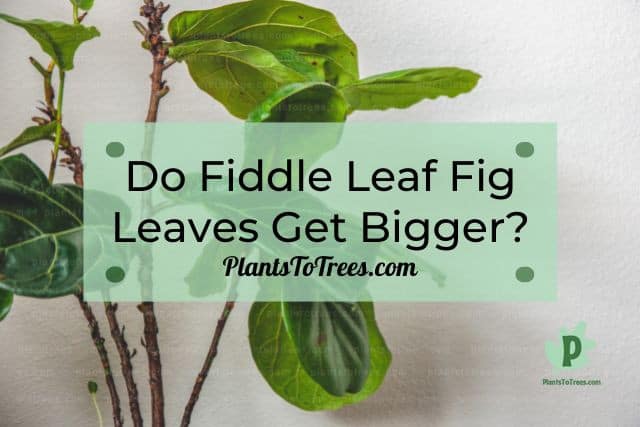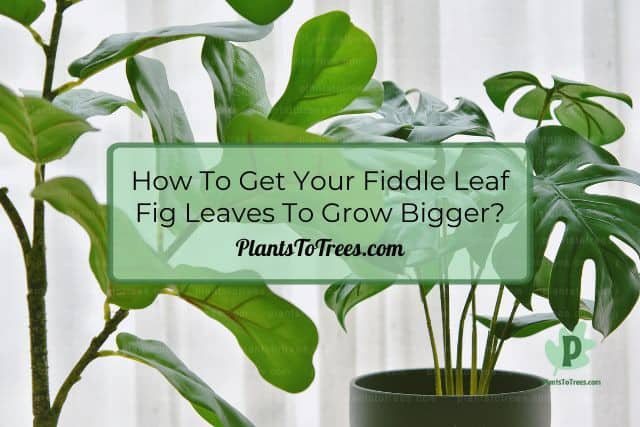If you’re asking yourself “Do fiddle leaf fig leaves get bigger,” then there may be a problem with your plant. The average leaf size of the fiddle leaf fig is between 8 to 15 inches long and 10 to 12 inches wide.

Fiddle leaf figs produce large leaves that can grow over 1 foot long and 1 foot wide. If your plant is producing much smaller leaves, it could be a sign that the fiddle leaf fig isn’t receiving the proper care. It could also be a symptom of pest or disease problems.
The best way to ensure your fiddle leaf fig produces those desirable large leaves is to ensure the plant has its ideal growing conditions. This means providing the plant with the right type and amount of sunlight, watering, temperature, and humidity. Without these basic needs, the fiddle leaf fig won’t grow properly and the entire health of the plant will suffer.
How To Get Your Fiddle Leaf Fig Leaves To Grow Bigger?

While no one wants their fiddle leaf fig to produce small leaves, there are some things you can do to help encourage the plant to grow the large foliage that this fig is known for.
The most common reason why your fiddle leaf fig leaves are small is that the plant isn’t receiving enough sunlight. This plant needs bright sun. Placing it in front of a window where it can receive direct sun in the morning or afternoon will ensure your plant produces those iconic large leaves.
Fiddle leaf figs need bright sunlight, and while not giving the plant enough light is the most common culprit for smaller leaves, it isn’t the only one. In fact, there are various things that can cause your fiddle leaf fig leaves to grow smaller than they should.
Properly Water The Fiddle Leaf Fig
How much or how little you water the fiddle leaf fig has a direct impact on how big the leaves will grow. To ensure the plant grows the correct size, avoid underwatering or overwatering. The exact amount you water the plant varies on the size and age of the fiddle leaf fig, as well as the time of year and environment it is currently growing in. A good general rule of thumb, however, is to water the plant once every 7 to 10 days.
Repot As Needed
Repotting is not something that you should do regularly with the fiddle leaf fig. However, not repotting the plant when it has outgrown its container will negatively affect the plant’s ability to produce large leaves. When the fiddle leaf fig’s roots start to grow out of the container’s drainage holes, you know it’s time to repot the plant in a bigger container.
When you do repot the fiddle leaf fig, avoid using a container that is more than 3 times the size of the plant’s root ball. Additionally, only use containers that have drainage holes at the very bottom of the pot and avoid containers where the drainage holes are on the side. Holes at the sides of the pot mean that the very bottom of the soil will stay soggy at all times, which can lead to overwatering and root rot.
Use The Right Soil
Not all soil or growing medium works well for every plant, and trying to grow the fiddle leaf fig in a soil that doesn’t fit its needs will quickly impact the plant’s ability to grow properly. Fiddle leaf figs need a growing medium that has a high organic matter. A potting soil that is peat-based can work okay, but you should first amend it with perlite to help improve its ability to drain properly. A good general recipe for fiddle leaf fig potting soil is 1/3 perlite mixed with 2/3 peat. Consider adding some compost or worm casting to the mixture to help up the organic matter content.
Add Compost Or Fertilizer To The Fiddle Leaf Fig
Houseplants, such as the fiddle leaf fig, will need to be fertilized every so often to help promote healthy, strong growth and larger leaves. This plant needs a fertilizer that has a bit more nitrogen, so look for a fertilizer with a NPK ratio of 3-2-1. Alternatively, use compost to help feed the fiddle leaf fig. Worm castings and fish emulsions are both good organic options if you don’t want to use commercially available fertilizers.
Maintain Mild Temperatures
Fiddle leaf figs are tropical plants that thrive in warm environments that have a constant temperature of between 60 and 75 degrees Fahrenheit. Additionally,exposing the plant to air that is too hot or too cold, such as drafty areas, will stunt the plant’s growth and make it difficult for it to produce large leaves. Because of this, you should keep the fiddle leaf fig away from exterior doors and drafty windows, as well as away from heating and cooling vents.
Look For Pests
Common sap-sucking insects, such as spider mites and mealybugs, can attack fiddle leaf figs and feed on the plant juices. This can weaken the plant and slow its growth, which means the fiddle leaf fig’s leaves may not grow as large. Thankfully, these pests are usually more of an annoyance than a serious problem, and can be rather easily dealt with. Horticultural oil and insecticidal soap are two effective pest control methods for these sap-sucking insects. They are also considered safe to use indoors around children and pets.
Related Articles
Why Does My Fiddle Leaf Fig Leaves Point Up Or Down? (How To Fix/Prevent)
Fiddle Leaf Fig Stem Turning Brown? (How To Fix/Prevent)
PlantsToTrees.com is the owner of this article and we first published this on March 2, 2023.
